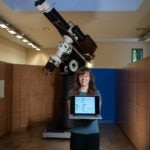How an asteroid-detection algorithm paved the way for a career in data science for me
Space Apps Challenge is an annual global contest where scientists and innovators from across the world compete to solve challenges facing the aerospace industry proposed by NASA. In 2016, I was one of the scientists that won this prize thanks to an algorithm capable of detecting and classifying Near Earth Objects, or NEOs. Today, I work as a data scientist at BBVA, where I develop fraud detection models. This is my story.

Our planet is surrounded by thousands of objects, including asteroids, comets and space waste. They orbit endlessly around us, trapped by the gravitational force of the Sun and other nearby stars. Due to their size and composition, NASA has classified some of them as ‘potentially hazardous asteroids,’ as their trajectory could make them come in contact with Earth at some point in time.
NASA monitors and tracks NEOs on an ongoing basis, in an effort to build its ability to determine their position at all times and their probability of collision against Earth. This was precisely one of the challenges that the space agency proposed to junior scientists from all around the world in the 2016 edition of its Space Apps Challenge, one of the world’s biggest hackathons. Specifically, the challenge was to develop a system capable of finding out "how Machine Learning could be used to help us avoid the same fate as the dinosaurs."
And this was the challenge that I, together with an exceptional team, set out to solve. The result was the Deep Asteroid, project, a smart Deep Learning-powered system, capable of determining when a change takes place (in shape, color, or chemical composition) in one of these objects to predict what it might do next. Our program was included in the global finalist shortlist. It was chosen among the 25 best worldwide projects, out of a total of over 2000 projects, and ranked in the top-5 within the ‘best use of data’ category. We used TensorFlow, Google’s open code library, to predict the chance of collision with Near Earth Objects (NEO): the algorithm we designed was capable of tracking the flight patterns of approximately 40,000 asteroids, 1,000 comets and hundreds of fragments of space debris.
Now, Google has included our project in its Search On video series, which features first-person accounts from people around the world that have used Google technology to solve big problems, answer hard questions and take action.
From 3D design to asteroids and finance
I was always interested in technology. I coded my first videogame at the age of 12, although, following my family tradition, I studied architecture and specialized in 3D rendering. Later, I founded my own animation and videogame company in Madrid, where I started to develop an interest in coding, enrolling in a programming course to understand the technical processes that go into the creation of products. It was my research in the field of software that awoke my interest in data science..
In particular, I was fascinated by the world of machine learning and decided to pursue a formal education to become a data scientist. It was precisely during while I was pursuing my education in the field that I started signing up to take part in different competitions, to test the knowledge and skills I was building, and this was one of them. In fact, it was as a result of my involvement in this competition that I was offered the opportunity to present my project during the Big Data Spain event. And here is where I met some people from BBVA Labs and how I got the chance of joining the bank and start working as a data scientist.
Today I work in the design and execution of machine learning models related to the world of finance. Specifically, I work applying this technology to improve the bank’s fraud detection capabilities. One of the things I enjoy most about my day to day work is facing new hypotheses and putting them to the test on an ongoing basis. We never settle with previously-built examples, and question each case, always looking for the best solution to apply these models to the world of banking.
A part of my work also involves reading and analyzing scientific publications in order to thoroughly understand, from a mathematical and conceptual standpoint, the latest advances in and finding potential applications to our daily work. Working with huge datasets requires thinking big, at huge scales.
I could never have imagined that what started as a challenge to detect asteroids would lead me to use the same technology to fight financial fraud and develop my career.
*Gema Parreño is Data Scientist at BBVA Labs.
*The photo of the header is owned by Google.